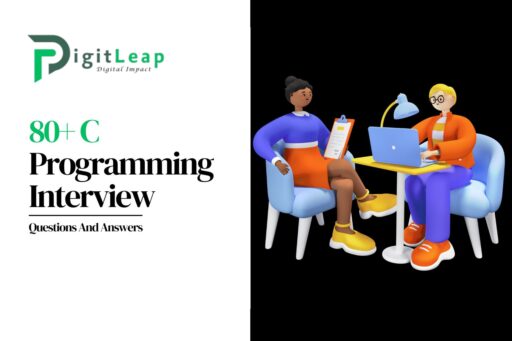80+ C Programming Interview Questions and Answers for 2025: Your Ultimate Guide to Mastering C Programming Interviews
Whether you’re a seasoned developer or just starting your journey in C programming, preparing for technical interviews can be daunting. To help you succeed in 2025, we’ve put together a comprehensive list of 80+ questions—covering basic concepts, advanced topics, data structures, memory management, and more—along with clear, humanized sample answers. Use this guide as a study aid to sharpen your skills and boost your confidence for your next interview.

Basic Concepts
- What is the C programming language?
Answer: C is a high-performance, general-purpose programming language developed in the early 1970s by Dennis Ritchie. It provides low-level access to memory and is known for its efficiency and portability. - What are the key features of C?
Answer: C is known for its simplicity, efficiency, portability, and ability to handle low-level operations. It supports structured programming, recursion, and modular programming. - What is a variable in C?
Answer: A variable is a storage location identified by a name that holds data which can be modified during program execution. - What is a data type?
Answer: Data types specify the type of data a variable can hold, such asint,float,char, etc. - Explain the concept of constants in C.
Answer: Constants are fixed values that do not change during program execution. They can be defined using the#definedirective or theconstkeyword. - What is the difference between
==and=in C?
Answer: The=operator assigns a value to a variable, whereas==compares two values for equality. - What are operators in C?
Answer: Operators are symbols that perform operations on variables and values. They include arithmetic, relational, logical, bitwise, assignment, and more. - What is the purpose of the main() function?
Answer: Themain()function is the entry point of a C program, where execution begins. - What are comments and why are they important?
Answer: Comments are non-executable parts of the code used to explain and document code logic. They improve readability and maintainability. - Explain the concept of a compiler.
Answer: A compiler translates C code into machine code that the computer can execute. It checks for syntax errors and optimizes the code for performance.
Control Structures
- How does the
ifstatement work?
Answer: Theifstatement executes a block of code if a specified condition is true. - What is the difference between
ifandif-else?
Answer: Anifstatement executes code only when the condition is true, whereasif-elseprovides an alternative block of code if the condition is false. - How do you implement a
switchstatement?
Answer: Aswitchstatement evaluates an expression and executes the matching case block, allowing for multiple conditional branches. - What is a loop?
Answer: A loop repeatedly executes a block of code as long as a specified condition remains true. Common loops in C includefor,while, anddo-while. - How does a
forloop differ from awhileloop?
Answer: Aforloop is typically used when the number of iterations is known, while awhileloop continues until a condition is no longer true, making it more flexible. - What is a
do-whileloop?
Answer: Ado-whileloop executes its code block at least once before checking the condition at the end of the loop. - Explain the purpose of the
breakstatement.
Answer: Thebreakstatement terminates the nearest enclosing loop or switch statement immediately. - What does the
continuestatement do?
Answer: Thecontinuestatement skips the remaining code in the current loop iteration and proceeds to the next iteration.
Functions and Modular Programming
- What is a function in C?
Answer: A function is a self-contained block of code designed to perform a specific task, improving modularity and reusability. - How do you declare a function?
Answer: A function is declared by specifying its return type, name, and parameters (if any). For example:int add(int a, int b); - What is the difference between a function declaration and a function definition?
Answer: A function declaration (prototype) tells the compiler about the function’s name and parameters, while a function definition provides the actual code. - What is recursion, and can you give an example?
Answer: Recursion is a programming technique where a function calls itself. A common example is calculating factorials. - What are the benefits of using functions?
Answer: Functions promote code reusability, make programs easier to understand, and simplify debugging and maintenance. - How do you pass parameters by value and by reference?
Answer: In pass-by-value, a copy of the variable is passed, while in pass-by-reference, the actual memory address is passed, allowing the function to modify the original variable. - What is a function pointer?
Answer: A function pointer stores the address of a function, enabling dynamic function calls and callback implementations.
Pointers and Memory Management
- What is a pointer in C?
Answer: A pointer is a variable that stores the memory address of another variable. - How do you declare a pointer?
Answer: You declare a pointer by using the*symbol. For example:int *ptr; - What is pointer arithmetic?
Answer: Pointer arithmetic allows you to navigate through memory addresses. For instance, incrementing a pointer moves it to the next memory location based on its data type. - Explain the concept of dynamic memory allocation.
Answer: Dynamic memory allocation is the process of allocating memory during runtime using functions likemalloc(),calloc(), andfree(). - What is a memory leak, and how can it be prevented?
Answer: A memory leak occurs when allocated memory is not freed properly, leading to wasted resources. It can be prevented by ensuring everymalloc()has a correspondingfree(). - What is the difference between
malloc()andcalloc()?
Answer:malloc()allocates a block of memory without initializing it, whilecalloc()allocates and initializes the memory to zero. - What is a NULL pointer?
Answer: A NULL pointer is a pointer that does not point to any memory location, used to indicate an uninitialized or invalid pointer.
Arrays, Strings, and Structures
- What is an array in C?
Answer: An array is a collection of elements of the same data type stored in contiguous memory locations. - How do you declare and initialize an array?
Answer: For example,int numbers[5] = {1, 2, 3, 4, 5};declares and initializes an array of five integers. - What is a string in C?
Answer: A string is an array of characters terminated by a null character ('\0'). - How do you manipulate strings in C?
Answer: The C standard library provides functions likestrcpy(),strlen(), andstrcat()for string manipulation. - What is a structure in C?
Answer: A structure is a user-defined data type that groups related variables of different types under one name. - How do you define and use a structure?
Answer: For example,cCopyEditstruct Person { char name[50]; int age; }; struct Person p; strcpy(p.name, "Alice"); p.age = 30; - What are unions, and how do they differ from structures?
Answer: A union is similar to a structure but shares memory among its members, meaning only one member can store a value at any given time. - What is the purpose of the
typedefkeyword?
Answer:typedefis used to create an alias for an existing data type, simplifying code and improving readability.
File Handling
- How do you open and close a file in C?
Answer: Use thefopen()function to open a file andfclose()to close it. For example,FILE *fp = fopen("data.txt", "r");. - What modes are available in file handling?
Answer: Common modes include “r” (read), “w” (write), “a” (append), “r+” (read and write), etc. - How do you read from a file?
Answer: Functions likefscanf(),fgets(), orfread()can be used to read data from a file. - How do you write to a file in C?
Answer: Functions likefprintf(),fputs(), orfwrite()are used to write data to a file. - What is the importance of error checking in file handling?
Answer: Error checking ensures that your program can handle issues like missing files or read/write errors gracefully, preventing crashes and data loss.
Preprocessor Directives and Macros
- What is a preprocessor directive?
Answer: Preprocessor directives are commands that are processed before compilation begins, such as#includeand#define. - How do macros work in C?
Answer: Macros are defined using#defineand are used to create constants or inline functions that improve code readability and reduce repetition. - What is conditional compilation?
Answer: Conditional compilation uses directives like#ifdefand#endifto compile code selectively based on defined conditions.
Advanced Topics
- What is a pointer to a pointer?
Answer: It is a variable that stores the address of another pointer, allowing for multiple levels of indirection. - Explain the concept of a memory dump.
Answer: A memory dump is a snapshot of the memory contents at a specific point in time, often used for debugging. - What is the difference between stack and heap memory?
Answer: Stack memory is used for static memory allocation, while heap memory is used for dynamic memory allocation. Stack is limited but faster, whereas heap is larger but slower to access. - How do you implement recursion in C?
Answer: Recursion is implemented when a function calls itself. For example, calculating factorials or traversing trees can be done recursively. - What are inline functions?
Answer: Inline functions are a suggestion to the compiler to insert the function’s code directly at the call site, reducing function call overhead. - What is a segmentation fault, and what typically causes it?
Answer: A segmentation fault occurs when a program attempts to access a memory segment it isn’t allowed to. Common causes include dereferencing NULL or uninitialized pointers. - How do you use the
constkeyword in C?
Answer: Theconstkeyword is used to define variables that cannot be modified after initialization, ensuring data integrity. - What is volatile in C?
Answer: Thevolatilekeyword tells the compiler that a variable’s value may change at any time—preventing certain optimizations—useful in embedded systems. - Explain the difference between shallow copy and deep copy.
Answer: A shallow copy duplicates the top-level structure but not the nested objects, whereas a deep copy duplicates everything, ensuring that all data is copied independently.
Practical Coding and Debugging
- How do you debug a C program?
Answer: I use debugging tools like GDB, insert print statements, and review error logs to isolate and fix issues in the code. - What are common pitfalls in C programming?
Answer: Common pitfalls include memory leaks, pointer errors, off-by-one errors in loops, and improper use of recursion. Being mindful of these helps in writing robust code. - How do you handle error checking in C functions?
Answer: Functions often return error codes or NULL pointers when something goes wrong. It’s important to check these returns and handle errors gracefully. - What is the purpose of the
assertmacro?
Answer: Theassertmacro is used to enforce assumptions made by the program. If an assertion fails, the program terminates, helping to catch bugs during development. - How do you optimize C code for performance?
Answer: Performance can be optimized by reducing function calls, optimizing loops, using efficient algorithms, and minimizing memory allocation. - What is inline assembly, and when might you use it?
Answer: Inline assembly allows you to embed assembly code within C programs for performance-critical sections. It’s used when you need to leverage low-level hardware operations. - How do you ensure portability in your C code?
Answer: Writing portable C code involves adhering to standards (like ANSI C), avoiding platform-specific libraries, and using conditional compilation for different environments. - What is the significance of header files in C?
Answer: Header files contain function declarations and macros, enabling code reuse and modular programming. They help maintain clean, organized code. - How do you prevent header file conflicts?
Answer: Using include guards (#ifndef,#define,#endif) in header files prevents multiple inclusions and conflicts during compilation.
Concepts in Data Structures
- What is a linked list, and why is it used?
Answer: A linked list is a data structure where elements are stored in nodes, each pointing to the next. It’s used for its dynamic size and efficient insertion/deletion operations. - How do arrays differ from linked lists?
Answer: Arrays store elements in contiguous memory locations, while linked lists use nodes with pointers. Arrays allow fast index-based access, whereas linked lists offer flexible memory usage. - What is a stack, and how is it implemented in C?
Answer: A stack is a LIFO (last in, first out) data structure. It’s typically implemented using arrays or linked lists, with operations like push and pop. - Explain the concept of a queue.
Answer: A queue is a FIFO (first in, first out) data structure. Elements are added at the rear and removed from the front, making it ideal for scheduling tasks. - What is a binary tree, and why is it useful?
Answer: A binary tree is a hierarchical structure where each node has up to two children. It’s useful for efficient searching, sorting, and hierarchical data representation. - How do you traverse a binary tree?
Answer: Common traversal methods include in-order, pre-order, and post-order traversals, each serving different purposes in data processing.
Advanced Topics and Best Practices
- What is the difference between call by value and call by reference?
Answer: Call by value passes a copy of the variable, while call by reference passes the variable’s address, allowing direct modification. - Explain the concept of dynamic programming.
Answer: Dynamic programming is an optimization technique that solves complex problems by breaking them into simpler subproblems and storing their solutions. - What are the benefits of using modular programming in C?
Answer: Modular programming divides a program into separate modules, making the code easier to manage, debug, and reuse. - What is the significance of error handling in C?
Answer: Proper error handling ensures that a program can handle unexpected situations gracefully, improving reliability and user experience. - How do you handle multi-threading in C?
Answer: Multi-threading in C is typically managed using libraries like POSIX Threads (pthreads), allowing concurrent execution of code. - What is socket programming?
Answer: Socket programming involves using sockets to enable communication between two nodes over a network, facilitating tasks like client-server interactions. - How do you optimize code for embedded systems in C?
Answer: Optimization involves minimizing memory usage, reducing computational overhead, and ensuring code efficiency, which is critical for resource-constrained environments. - What are some best practices for writing maintainable C code?
Answer: Best practices include writing clear, well-documented code, using consistent naming conventions, modularizing code, and adhering to coding standards to enhance readability and maintainability. - How do you ensure your code is portable across different platforms?
Answer: Use standard libraries, avoid platform-specific features, and employ conditional compilation to manage differences between environments. - What is the role of debugging in the development process?
Answer: Debugging is essential for identifying and fixing errors. Using tools like GDB and incorporating logging helps streamline the debugging process. - What is a segmentation fault, and how can you prevent it?
Answer: A segmentation fault occurs when a program accesses restricted memory. It can be prevented by careful pointer management and thorough testing. - How do you handle memory allocation failures?
Answer: Always check the return value of memory allocation functions and implement error handling routines to manage failures gracefully.
Conclusion
These 84 questions and answers provide a comprehensive guide to mastering C programming interviews in 2025. From basic concepts to advanced topics, this list covers the key areas you need to be prepared for. By understanding these questions and practicing your answers, you’ll be well on your way to confidently acing your next interview.






